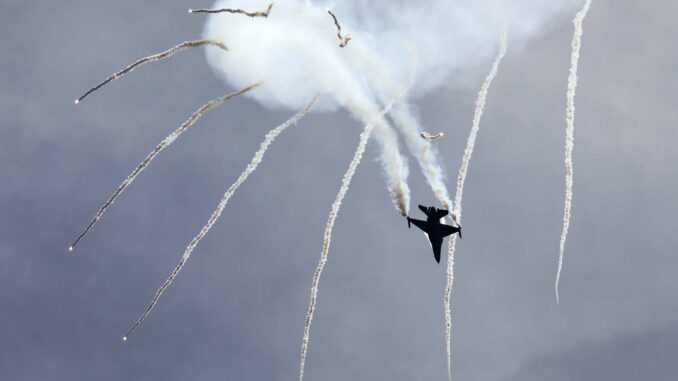
How are fighter jets armed? Explore the evolution, technology and strategies of modern fighter aircraft, and examine the ethical and legal impact of their advanced weaponry.
Fighter jets are military aircraft designed for air superiority, ground attack and reconnaissance missions. They are characterized by their high speed, maneuverability and ability to operate at different altitudes. For example, the F-22 Raptor, an American fighter, can reach speeds in excess of Mach 2 (approx. 2,470 km/h) and operate at altitudes of over 20,000 meters.
These aircraft are equipped with advanced navigation and weapons systems, often including AESA (Active Electronically Scanned Array) radar for target detection and tracking. Their aerodynamic design is optimized for combat performance, using materials such as light alloys and composites to reduce weight and increase structural strength.
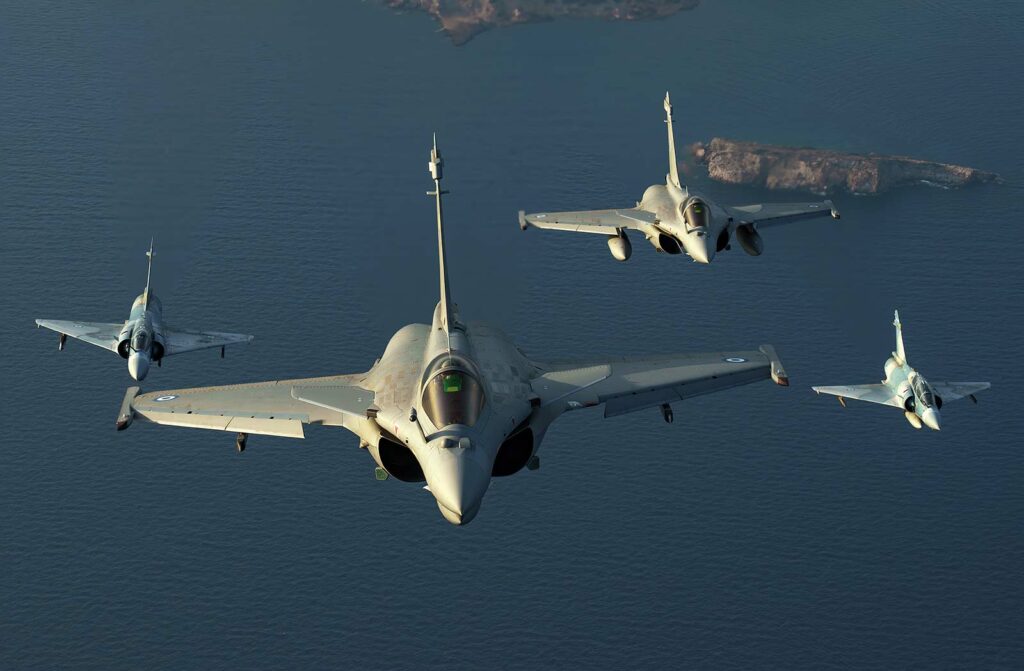
The importance of weaponry in fighter missions
Armament is a central component of fighter aircraft, enabling them to carry out their missions effectively. These missions can range from air superiority (dominating the skies by neutralizing enemy aircraft) to ground attack (targeting enemy structures or vehicles).
An example of a commonly used weapon is the AIM-120 AMRAAM (Advanced Medium-Range Air-to-Air Missile). This missile, 3.66 meters long and weighing around 152 kg, can reach targets up to 180 km away. It is designed for engagements beyond visual range, enabling pilots to strike enemy targets even before they are detected.
Fighter jets are also equipped with weapons for air-to-ground missions, such as GBU-12 Paveway II bombs. These 500 kg bombs are laser-guided, enabling precision strikes with a margin of error of less than one meter. This kind of precision is crucial to minimize collateral damage in complex combat environments.
History of fighter armament
The beginnings of aerial armament in world conflicts
The first use of military aircraft dates back to the First World War. Initially, these aircraft were mainly used for reconnaissance. As the war progressed, however, they were armed for combat. The German Fokker Eindecker, introduced in 1915, is often considered one of the first true fighter aircraft. It was equipped with a synchronized 7.92 mm machine gun, enabling the pilot to fire through the arc of the propeller without damaging it.
Technological evolution over the years
During the Second World War, the armament of fighter aircraft underwent a significant evolution. Aircraft such as the British Spitfire were equipped with .303 (7.7 mm) Browning machine guns and, later, 20 mm Hispano cannons. The Spitfire Mk VB, for example, had a wingspan of around 11.23 meters and was capable of reaching speeds of 600 km/h.
The jet age, which began shortly after the Second World War, introduced aircraft such as the American F-86 Sabre. The Sabre, with a top speed of almost 1,100 km/h, was armed with six .50-caliber (12.7 mm) M3 machine guns, each with a rate of fire of around 1,200 rounds per minute.
Some outstanding examples of historic fighter aircraft and their armament
Messerschmitt Me 262 (Second World War)
The world’s first operational jet fighter.
Armed with four MK 108 30 mm cannons, with an effective range of around 600 meters.
Maximum speed of around 870 km/h.
Mikoyan-Gurevich MiG-15 (Korean War)
An iconic Soviet jet.
Armed with a 37 mm Nudelman N-37 cannon and two 23 mm Berezin B-23 guns.
Capable of reaching a maximum speed of 1,075 km/h.
McDonnell Douglas F-4 Phantom II (Vietnam War)
A versatile supersonic fighter.
Initially unarmed with cannon, it was later fitted with a 20 mm M61 Vulcan cannon.
Capable of flying at speeds in excess of Mach 2.4 (approx. 2,500 km/h).
These examples illustrate how fighter armament has evolved from simple machine guns to sophisticated cannons and missiles, in parallel with advances in speed, maneuverability and aircraft technology.
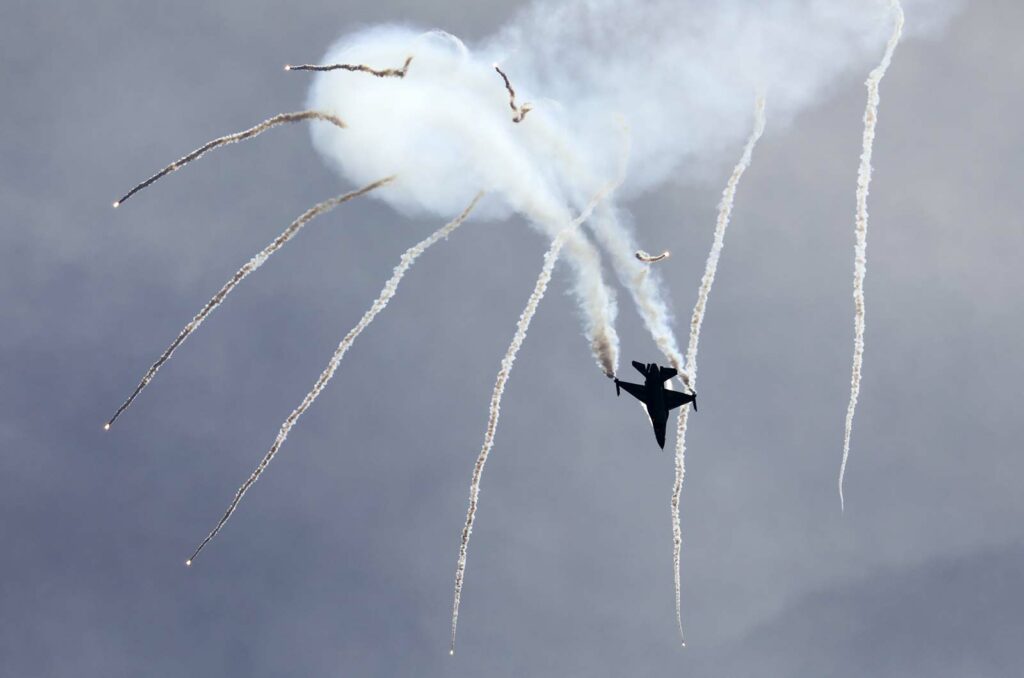
Types of weapons used in modern fighter aircraft
Offensive weapons
Air-to-air missiles: These missiles are designed to engage and destroy other aircraft. For example, the AIM-120 AMRAAM (Advanced Medium-Range Air-to-Air Missile) has a range of over 100 km, is about 3.7 meters long, and weighs around 150 kg. It is equipped with an active radar seeker, offering a “shoot-and-forget” strike capability.
Air-to-ground missiles: Designed to target ground installations or vehicles. The AGM-65 Maverick missile is an example, with a variety of warheads and guidance systems, such as infrared imaging for precision strikes. The Maverick has a length of around 2.5 meters, a weight of up to 300 kg, and an effective range of around 22 km.
Guided bombs: These bombs are equipped with guidance systems for enhanced precision. The GBU-12 Paveway II, a laser-guided bomb, is around 3.2 meters long and weighs around 230 kg. It is capable of hitting targets with great precision, often within a few meters of the objective.
Unguided bombs: Less precise, but still used for area targets. For example, the Mk 82, a free-fall bomb, weighs around 227 kg and is often used in combination with other systems to increase its accuracy.
Guns: Modern fighter aircraft are often equipped with guns for close combat or ground attack. The GAU-8/A Avenger cannon, mounted on the A-10 Thunderbolt II, is a notable example. This 30 mm cannon can fire up to 4,200 rounds per minute.
Defensive weapons
Flares: Include flares and chaff, used to fool enemy missile guidance systems. Flares emit intense heat to divert infrared-guided missiles.
Electronic countermeasures: These systems jam or deceive enemy radar and missile guidance systems. For example, the AN/ALQ-131 Electronic Countermeasure Pod can disrupt a range of radar frequencies, protecting the aircraft against enemy radar guidance systems.
Jamming systems: Designed to interfere with enemy radar and communications. The ALQ-99 Tactical Jamming System, for example, can jam several frequency bands, making it difficult for the enemy to detect or track the aircraft.
Physical protection: Radar-absorbing materials (RAM) are often used on fighter jets to reduce their radar signature, making the aircraft more difficult to detect.
These offensive and defensive weapons systems illustrate the complexity and technological sophistication of modern fighter aircraft, enabling a variety of tactical and strategic missions in diverse combat environments.
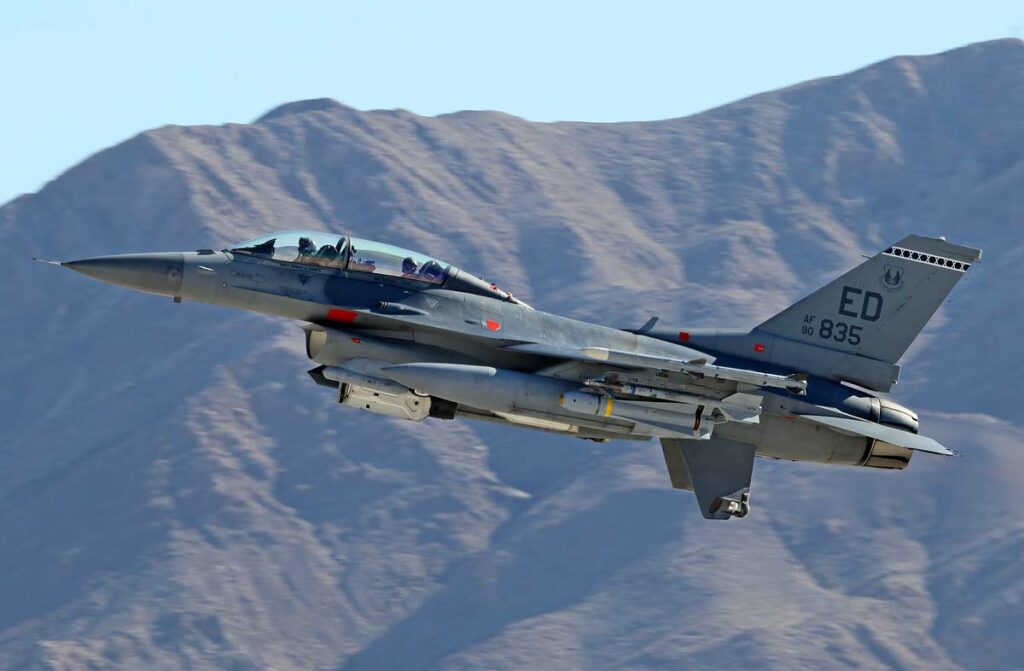
Advanced weapons systems and technologies
Precision-guided weapons
Precision-guided weapons have revolutionized the offensive capabilities of fighter aircraft, enabling precise strikes with reduced collateral damage.
Precision-guided missiles: The AGM-114 Hellfire missile, often used on aircraft and UAVs, is one example. This air-to-ground missile is 1.6 meters long, 0.18 meters in diameter, and weighs around 45 kg. It uses semi-active laser guidance, enabling precise strikes at a maximum distance of 8 km.
Guided bombs: Another example is the GBU-39 Small Diameter Bomb (SDB). Measuring 1.8 meters in length and weighing 129 kg, it uses a GPS guidance system to hit targets with pinpoint accuracy from a distance of over 70 km.
Integrated and automated weapons systems
Integrated and automated weapons systems enhance the efficiency and responsiveness of fighter aircraft, particularly in complex combat environments.
Advanced targeting systems: Aircraft like the F-35 Lightning II are equipped with integrated targeting systems that combine radar, visual recognition and electronic data to identify and track targets. The F-35’s Electro-Optical Targeting System (EOTS) enables precise detection without compromising the aircraft’s stealth.
Weapons automation: Some weapons systems are capable of automatically engaging targets according to predefined parameters, reducing reaction time and increasing combat effectiveness.
Examples of advanced fighter aircraft and their equipment
F-22 Raptor: This American fighter is an example of cutting-edge technology. It is around 18.9 meters long, with a 13.6-meter wingspan, and can reach speeds in excess of Mach 2. It is equipped with AIM-120 AMRAAM and AIM-9 Sidewinder air-to-air missiles, as well as a 20-mm M61A2 Vulcan internal cannon.
Sukhoi Su-57: Russia’s fifth-generation fighter, the Su-57 combines stealth, supersonic speed and advanced weaponry. It is 19.8 meters long and has a wingspan of 14.1 meters. Its weapons include air-to-air missiles, air-to-ground missiles and a 30 mm cannon.
Eurofighter Typhoon: This European multi-role aircraft, with a length of 15.96 meters and a wingspan of 10.95 meters, is capable of Mach 2. It is armed with air-to-air missiles such as the AIM-120 AMRAAM, Paveway guided bombs, and a 27 mm internal cannon.
These advanced technologies and weapons systems demonstrate how modern fighter aircraft are equipped for a wide variety of missions, with enhanced capability for precise and effective operations in diverse combat environments.
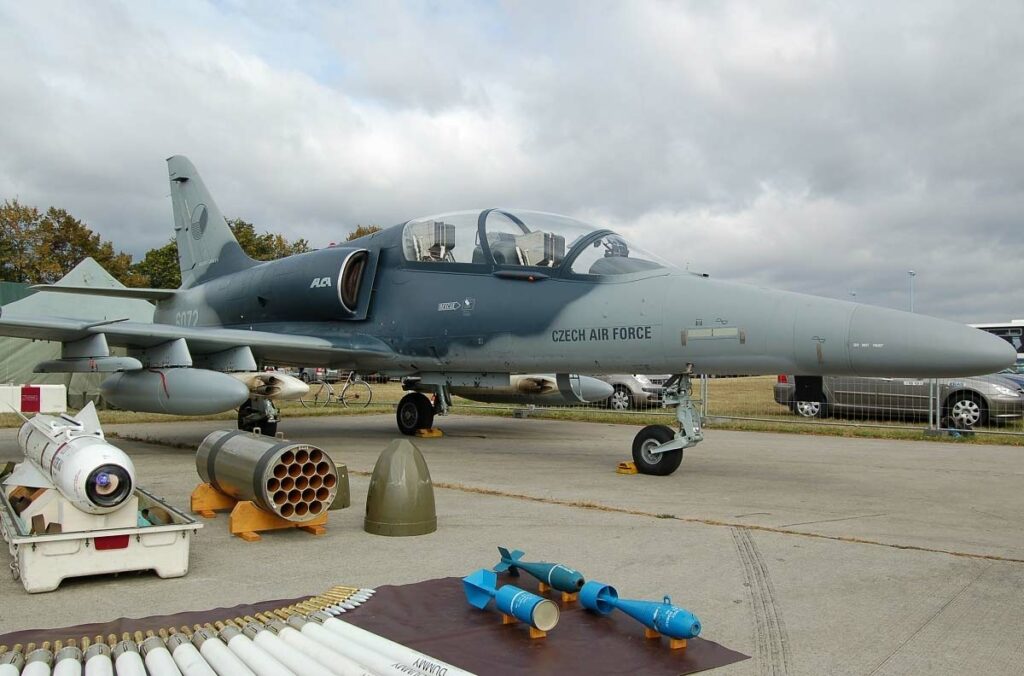
Impact of weaponry on military air strategies
Attack and defense strategies
Fighter armament has a direct impact on attack and defense strategies in air operations.
Attack: Precision air-to-ground missiles, such as the AGM-158 JASSM (Joint Air-to-Surface Standoff Missile) with a range of over 370 km, enable long-range attacks against well-defended strategic targets. Their accuracy and range offer attack capability without exposing the aircraft to dense enemy defenses.
Defense: In defense, fighter jets use short- and long-range air-to-air missiles to maintain air superiority. For example, the AIM-9X Sidewinder missile, with a range of 35 km and high maneuverability, is effective in close air-to-air combat.
Tactical implications of different weapons
Weapon characteristics influence the tactics used during missions.
Guided vs. unguided bombs: The use of guided bombs such as the GBU-12 Paveway II, with an accuracy of a few meters, is favored for targets requiring surgical precision, while unguided bombs are used for area strikes, as in missions to suppress enemy air defenses.
Long-range missiles: Missiles such as the Russian R-37, with a range of up to 400 km, can engage targets from great distances, modifying air force engagement and positioning strategies.
Examples of missions and their execution according to armament
Suppression of Enemy Defenses (SEAD): In a SEAD mission, aircraft like the F-16CJ are equipped with AGM-88 HARM missiles to destroy enemy radars. The HARM, with a range of around 150 km, can detect and attack radar sources, enabling a safe advance of allied forces.
Air interdiction: Fighter aircraft, armed with long-range air-to-air missiles such as the AIM-120 AMRAAM, are used to prevent enemy aircraft from entering a specific area. This strategy is crucial for protecting sensitive areas or ground forces.
Precision attack: For targets requiring precise elimination, such as nuclear facilities or bunkers, aircraft like the F-35 can use GPS-guided bombs, like the GBU-31 JDAM, to ensure precise destruction with minimum collateral damage.
These examples demonstrate the importance of weaponry in formulating air military strategies, with each type of weapon having a specific role that influences the way missions are planned and executed.
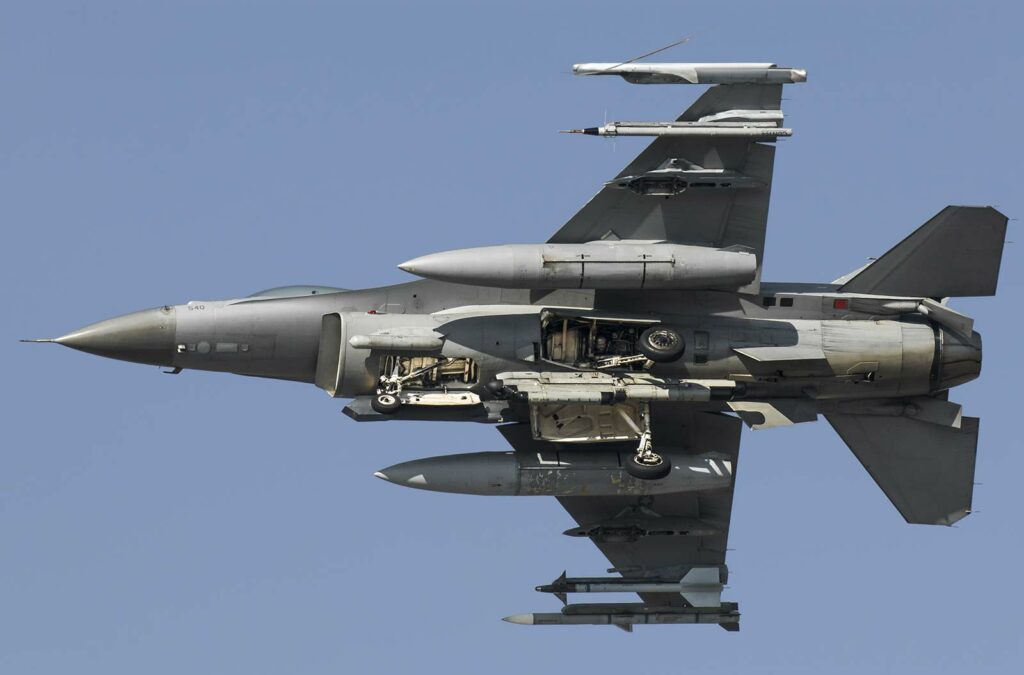
Ethical and legal issues of air weaponry
International rules governing the use of weapons
The use of air weapons is governed by various international agreements and conventions designed to limit collateral damage and protect civilians in wartime.
Geneva Convention: This convention, and its additional protocols, lay down rules for the protection of civilians during armed conflicts. For example, it prohibits the indiscriminate use of weapons which may cause superfluous injury or unnecessary suffering.
Arms Trade Treaty (ATT): Adopted by the United Nations General Assembly, this treaty aims to regulate the international trade in conventional weapons, including fighter aircraft and their armament, to prevent them being used to violate human rights or international humanitarian law.
Debates on excessive weaponry and precision strikes
Technological evolution has led to a debate on the ethical and legal use of advanced weaponry.
Precision strikes: Although precision weapons such as GBU-12 Paveway II laser-guided bombs reduce collateral damage, their use raises questions about the legitimacy of targets and responsibility in the event of errors.
Armed drones: The use of armed drones for targeted strikes, such as MQ-9 Reapers equipped with Hellfire missiles, is controversial due to questions of accountability, surveillance, and the risk of dehumanizing combat.
Impact of advanced weaponry on future conflicts
Advances in aerial weaponry are transforming military strategies and posing challenges for international law.
Hypersonic weapons: Hypersonic weapons, capable of traveling at over Mach 5, pose a challenge for detection and defense. Their future integration into air arsenals could radically change the nature of military engagements.
Cyberwarfare and electronic jamming: Weapon systems integrated into modern fighter aircraft, such as those on the F-35 Lightning II, are susceptible to cyberattack, raising questions about the security and sovereignty of weapons systems.
The ethical and legal issues surrounding air weapons encompass not only rules of engagement and international conventions, but also the implications of technological advances on the nature and conduct of future conflicts. These developments call for ongoing reflection on the balance between military effectiveness and ethical and legal responsibility.
War Wings Daily is an independant magazine.